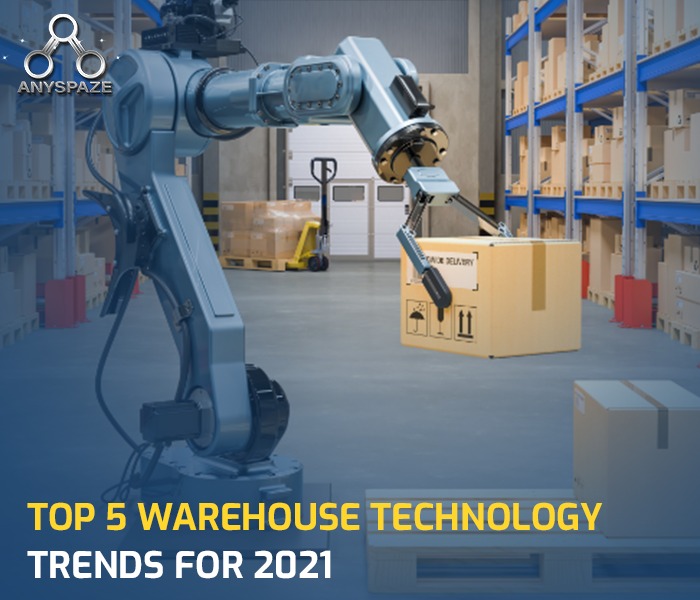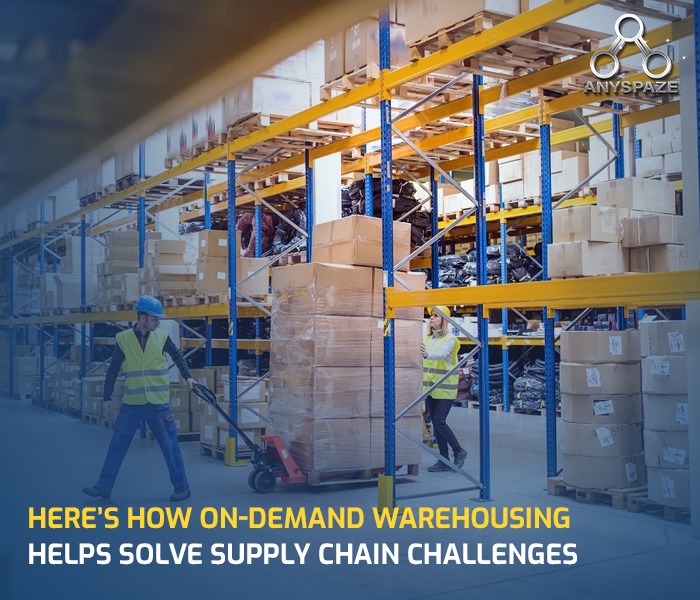Previous
Top 5 Warehouse Technology Trends For 2021
October 29, 2021
As Technology Advances, New And Inventive Solutions Become Available. In Today's Society, Technology Has Become The Backbone Of Every Industry. In Order For Businesses To Thrive In The Future, They Must Adapt To Technology Advancements. Warehousing Is The Core Of E-Commerce Businesses And This Way The Warehouse Industry, In Particular, Has Benefited From Technological Advancements.
If You Run E-Commerce, Startups, Or Drop Shipping Business, You'll Understand How Warehouse Management Becomes More Challenging As Your Company Grows. However, You Might Choose To Outsource Logistics Procedures Such As Inventory Management, Transportation Operations, Freight Management, Warehousing, And Other Associated Services To The 3PL Market.
Because E-Commerce Sites Handle A Huge Number Of Orders, It's Best To Delegate Warehousing To A 3PL (Third-Party Logistics) Firm That Employs Cutting-Edge Warehousing Technology Capable Of Processing Thousands Of Orders. You Can Improve Your Service Delivery And Increase Your Revenue With This In Place. You Must Find Flexible Warehouse Rental Services Like Anyspaze Warehouse For Ecommerce Companies.
Because The Requirement For Mass Production And Bulk Handling Of Items Has Long Necessitated The Use Of Technology In Warehousing Operations, This Is The Case.
The Following Are Seven Technology Trends That Are Reshaping The Warehousing Industry:
1. IoT (IoT)

The Internet Of Things (IoT) Is The Worldwide Network Of Millions, If Not Billions, Of Connected Devices That Share Data Via The Internet.

You Can Now Make Almost Anything Part Of The Internet Of Things Via The Internet And Wireless Networks. Integrating Sensors To Objects Gives Them Digital Intelligence, Allowing Them To Communicate Directly Without The Use Of Humans.
Current Warehouse Automation Trends Are Being Driven By The Internet Of Things. It's Assisting In The Transformation Of Today's Warehouse Into A Connected And Coordinated System. In 2021 And Beyond, Lower Costs And Enhanced IoT Sensors Are Expected To Boost The Use Of IoT In Warehouses.
You Can Link And Monitor Your Warehouse Robots, Drones, Pallets, Equipment, Beacons, And Inventory Using The Internet Of Things. It Also Allows You To Supervise Your Employees In Real Time From Afar. The Internet Of Things (IoT) Allows Objects And Systems To Gather, Store, And Share Data. It Also Enables Performance Assessments And Warehousing Monitoring For All Linked Devices, Including Such Monitoring Of Temperature In Cold Storage And Vibrations Tracking In Engine Monitoring.
2. Artificial Intelligence And Robots
Robots Have Taken On Significant Roles In Warehouses All Over The World. Robotic Factories Are Expected To Number Approximately 50,000 By 2025, With Over 4 Million Robot Deployments.
In Warehouses, Robots Can Help With Jobs Like:
● Choosing
● Shipping
● Sorting
● Grouping
● Transferring
● Inspections
● Security
Several Large Distribution Businesses Have Already Spent Millions Of Dollars To Improve Their Fulfilment Centres And Delivery Efficiency. Robots Can Handle Tens Of Thousands Of Requests And Billions Of Products Per Week. In Some Warehouses, Using Robots Has Been Shown To Increase Efficiency And Lower Labour Costs.
AGV/AMR Are Two Types Of Mobile Robots
Robots That Move Around Are Known As Mobile Robots. They're Made To Move Around In Places Like Warehouses, Stores, And Other Settings. They Could Either Be Led Or Left On Their Own Devices To Follow A Specified Path Or Route.
Guided Robots Often Rely On Other Devices For Navigation, Allowing Them To Follow A Predetermined Path. Multi-Linked Puppeteers And Grippers Are Attached To A More Or Less Stationary Surface In Other Forms Of Mobile Robots. AMRs, On The Other Hand, Are Meant To Navigate Surroundings Without The Assistance Of Humans.
Conveyors Are Being Replaced By Mobile Robots
Conveyors Are A Common Component In Warehouse Material Transfer, But Their Days Appear To Be Numbered. Smaller Mobile Robots, Which Are More Portable And Less Expensive, Appear To Be Well Positioned To Replace The Massive Traditional, Fixed Warehouse Systems.
The Requirement For More Efficient Space Usage Could Potentially Be A Factor In The Shift Away From Large Conveyors And Toward Mobile Automated Equipment. Small Logistics Operations Appear To Be Gravitating Toward Automation Companies' Robot-As-A-Service Models.
Drones -
Since Roughly 2013, Drones Have Steadily Become Fashionable In Warehouse Operations. The Use Of Warehouse Drones Has Grown In Popularity As Laws Have Been Relaxed, Software And Hardware Improvements Have Improved, And Prices Have Come Down.
A Few Of The Advantages Of Drones Are As Follows:
● Drones May Now Be Navigated Securely Without The Need Of GPS.
● When It Comes To Detecting And Identifying Stuff, They're Fairly Accurate.
● They're Both Cost-Effective And Scalable.
Modern Drones Can Shoot High-Definition Video And Link To The Cloud. They Can Hover Above Items And Reach Any Spot In The Warehouse On Their Own.
Drones Are Now Utilised For Shipping And Delivery, As Well As A Variety Of Other Tasks, Such As:
● Scanning Of Barcodes
● Getting To Inaccessible Places
● Counting Cycles
● Conducting Inventory Scans From The Air
● Stock Inspection
● Goods Retrieval
The Increasing Battery Life And Stability Of Drones Have Made Their Usage In Warehouse Automation Quite Popular.
Cobots
A Cobot Is A Robot That Collaborates With A Person On A Task. Collaborative Robots Are Another Name For Cobots. Cobots Are Expected To Grow In Popularity In Warehousing Due To Their Ability To Drastically Cut The Time It Takes To Complete Jobs. They're Also Popular Among Some Because They Don't Pose A Threat To Human Work. So, If You're Searching For A Cost-Effective Approach To Invest In Your Present Workforce, Consider Cobots. They're Inexpensive, Portable, And Simple To Programme, And They're Adaptable Enough To Work In Tight Warehouse Settings.
3. Modular Plug-And-Play Solutions
Be It Ecommerce, Startups Or Drop Shipping Companies, They Frequently Struggle To Effectively Predict Future Warehousing Demands. When Working With Underused Or Oversubscribed Technology, Flexibility Comes In Helpful.These Systems Can Be Reconfigured To Meet Changing Warehouse Requirements.
Presently, Warehouse Solutions That Use Plug-And-Play Technology To Rearrange Network Are Being Developed. When Warehouses Need To Transfer Or Resize, It Can Be Assembled, Transported, Demolished, And Reorganised. Plug-And-Play Could Be Used In Storage, Selecting, And Pick Systems, In Addition To Conveyor, To Enable For Speedy Order Aggregation.
4. Machines That Are Controlled By Software
In Warehouses, Automation Aims To Increase Efficiency, Speed, And Safety. Forklifts, Drones, Pallet Movers, Local Delivery Trucks, And Floor Cleaners Are Just A Few Examples Of Warehousing Equipment That Can Now Be Automated Thanks To Advances In Big Data, Remote Systems, And Computer Vision. Once These Machines Have Been Automated, They Will Be Able To Work Effectively With Very Little Human Intervention.
Amazon Is Among The Organisations That Uses This Technology Through Their Kiva Bots, Which Are Computerized And Work On The Warehouse Shelves, Picking Up Items, Storing Them, And Managing Inventory. They Can Also Sort Packages On Their Own.
5. Assistants That Speak To You
With Today's Warehouse Technologies, You May Use Your Voice To Operate Many Processes, Interfaces, And Devices. You Can Begin The Selection Procedure By Speaking Into A Microphone, Which Instructs A Robot To Do So. Voice Can Be Used To Turn On And Off Lights, Call For Help, And Interact With Devices. A Combination Of Voice Technology And Augmented Reality (AR) Can Be Utilised To Provide A Digital Environment To An Audience.
Final Thoughts -
Despite Advancements In Warehousing Technology, Manual Labour Is Still Required In The Majority Of Warehouses Today. This Is Mostly Due To Worries About Transition Planning, Acquisition Prices, Implementation Difficulties, And Maintenance Needs.
As A Result, If You're Thinking About Implementing New Warehousing Technology In Your Company, These Are Some Of The Issues To Think About. Don't Forget To Consider The Influence On Your Staffing Requirements And Maintenance Expenditures.
If Your Company Is Ready To Adopt Modern Technology, You're Probably Already Equipped To Face These Issues. Find Warehouse Rental Services Which Are Best Suited For You.
We Take Great Satisfaction In Providing Clients With Warehousing And Logistics Solutions That Are Quick, Flexible, And Cost-Effective. With Anyspaze Warehouse For Ecommerce Companies, You May Expand Your Business Without Fuss And Properly Manage Your Inventories.




